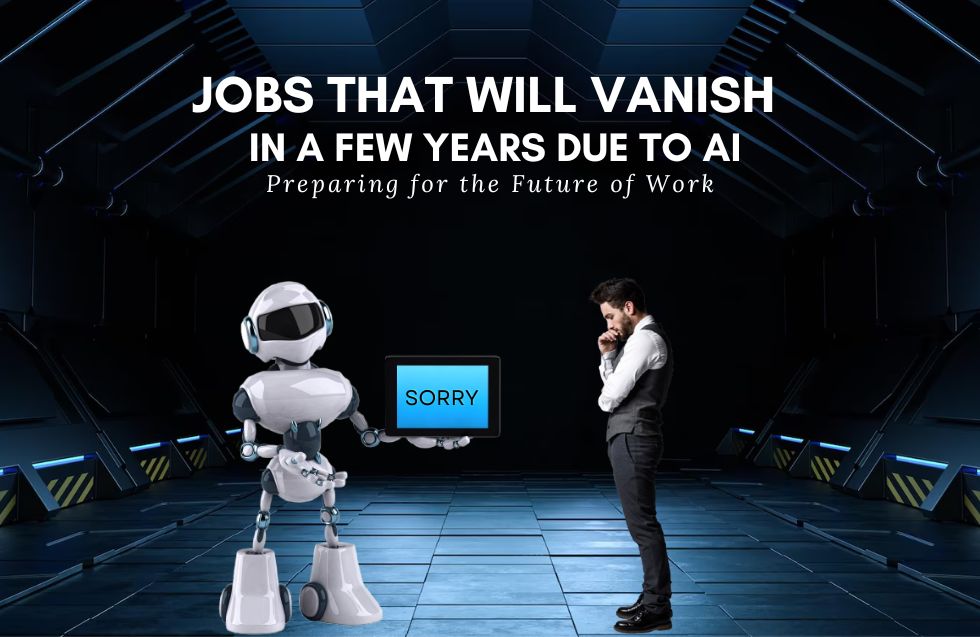Artificial Intelligence (AI) is rapidly transforming industries worldwide, automating tasks, and improving efficiency in ways once unimaginable. While AI brings tremendous benefits, it also has a disruptive side—many jobs are expected to vanish in the near future as AI continues to advance. In this blog, we’ll explore some of the jobs most likely to disappear due to AI and how workers in these fields can prepare for the future.
1. Data Entry Clerks
Data entry jobs are prime candidates for automation. Due to AI algorithms are now capable of processing vast amounts of information faster and more accurately than human data entry clerks. With technologies like Optical Character Recognition (OCR) and Machine Learning (ML), mundane data input tasks can be handled by machines, reducing the need for human intervention.
What Can Workers Do?
Data entry professionals should consider upskilling in data analysis, digital tools, or administrative roles that require more critical thinking and problem-solving.
2. Telemarketers
Telemarketing is already in decline due to AI-powered chatbots and voice recognition systems. These systems can engage in basic customer interactions, make calls, and handle inquiries with greater efficiency and less cost than human telemarketers. As AI-driven virtual assistants become more sophisticated, the need for human telemarketers will continue to shrink.
What Can Workers Do?
Skills in digital marketing, customer relationship management (CRM), and online sales are more sustainable alternatives for those working in telemarketing.
3. Retail Cashiers
Self-checkout systems, powered by due to AI, are becoming increasingly common in grocery stores, malls, and other retail environments. The rise of fully automated stores, like Amazon Go, eliminates the need for traditional cashiers. As the technology improves, more retailers will adopt these systems to reduce labor costs and enhance customer experience.
What Can Workers Do?
Retail workers can focus on upskilling in areas such as customer service, inventory management, or roles requiring more human interaction, like personal shopping assistants.
4. Assembly Line Workers
Robotic automation has been reshaping manufacturing for decades, but due to AI is now taking things a step further. AI-powered robots can handle increasingly complex tasks on assembly lines, from assembling components to conducting quality checks. This shift is reducing the demand for human assembly line workers, especially in industries like electronics, automotive, and consumer goods.
What Can Workers Do?
Workers in manufacturing should explore training in robotics, maintenance of automated systems, or production management, where human oversight remains crucial.
5. Bank Tellers
Banking is undergoing significant digital transformation, with more customers opting for online banking and mobile apps over visiting physical branches. AI-driven tools like chatbots, virtual assistants, and automated financial advice are replacing traditional bank tellers, making it easier for people to conduct transactions without human assistance.
What Can Workers Do?
Bank tellers should consider transitioning into roles in financial advising, digital banking services, or customer relationship management, where they can offer personalized services due to AI cannot replicate.
6. Truck Drivers and Delivery Couriers
Self-driving vehicles, powered by due to AI, are rapidly advancing. Companies like Tesla, Waymo, and Uber are developing autonomous trucks and delivery vehicles that could soon replace human drivers. Although widespread adoption is still a few years away, the trajectory of development suggests that the trucking and delivery industries will be heavily impacted by automation.
What Can Workers Do?
Truck drivers and couriers should consider transitioning into logistics management, fleet supervision, or roles within the broader supply chain industry that requires human expertise.
7. Customer Service Representatives
AI chatbots and virtual assistants are increasingly handling customer service inquiries, from answering basic questions to troubleshooting common problems. As AI systems become more sophisticated, they will be able to handle a larger share of customer interactions, reducing the demand for human customer service representatives.
What Can Workers Do?
Customer service representatives should focus on acquiring skills in more complex problem-solving roles or transitioning to customer experience management, where emotional intelligence and human insight are critical.
8. Accountants and Bookkeepers
AI can automate many of the tasks performed by accountants and bookkeepers, such as tax preparation, invoice management, and financial reporting. With AI-powered accounting software handling routine tasks, the demand for entry-level accountants and bookkeepers is expected to decline.
What Can Workers Do?
Accountants can future-proof their careers by focusing on advisory roles, financial strategy, and analysis, where human judgment is essential.
9. Journalists and Content Writers
AI content generation tools, such as GPT models, are increasingly being used to create basic news articles, blog posts, and other written content. Although human creativity and insight are still valuable, AI can handle the production of routine content, potentially reducing the demand for entry-level writing jobs.
What Can Workers Do?
Writers should focus on developing skills in creative content creation, storytelling, and specialized niches where human insight and emotional connection are necessary, such as investigative journalism or in-depth analysis.
10. Warehouse Workers
Warehouse operations are rapidly being automated, with AI-powered robots and drones handling tasks like inventory management, packing, and shipping. Amazon, for example, has implemented AI-driven robots in many of its fulfillment centers, reducing the need for human warehouse workers.
What Can Workers Do?
Warehouse workers should consider training in robotics maintenance, supply chain management, or roles that involve the oversight of automated systems.
How to Prepare for the Future of Work
As AI continues to disrupt the job market, workers need to stay ahead by learning new skills, especially in fields that require critical thinking, creativity, emotional intelligence, and strategic oversight—areas where AI still struggles to replace humans. Upskilling in technology, digital literacy, and industries that rely on human intuition and empathy can help ensure a stable future.
Here are some tips for preparing for the AI-driven future of work:
- Continuous Learning: Stay updated with emerging trends and skills in your industry.
- Explore Tech-Related Roles: Familiarize yourself with AI, robotics, and data analysis to remain relevant in an increasingly automated workforce.
- Adaptability: Be open to change and willing to transition into new roles or industries as technology evolves.
The future of work will look very different, but those who adapt and leverage new opportunities will thrive in the age of AI.













